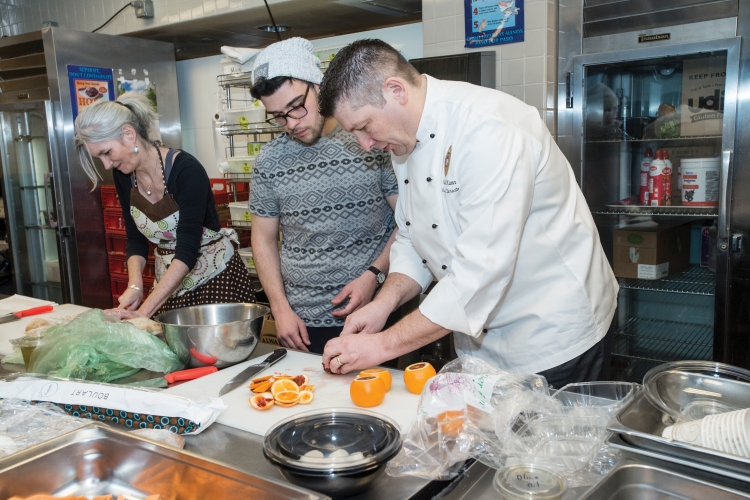
By
Most classes taught at the University require time in a library or with study groups to achieve a passing grade, but one new course features an assignment that requires students to get their hands dirty – literally.
A recent session of the English Department creative writing seminar Food and Culture Writing took place in the Lyons Hall kitchen, as students – with Boston College Dining Services cooks standing by to help – carried out the assignment of creating a menu and then preparing a meal, based on ingredients they had been researching.
“I think it’s difficult to write about food when you’re not immersed in a context connected to it, whether it be a market, a garden, a kitchen,” says seminar leader Lynne Anderson, a part-time faculty member and director of English Language Learning, and author of the book Breaking Bread, Recipes and Stories from Immigrant Kitchens.
The third of four assignments for the class, this hands-on exercise required students to pursue a journalistic food profile, where they would research a particular ingredient – such as how to cultivate, shop for, or prepare a particular vegetable – and then develop a recipe around it, Anderson explains.
“The night at Lyons was a great success: Students worked well together and created a lovely meal. The experience will certainly inform their writing of the ingredient profile because all of the chopping, mixing, kneading, sautéing, etc., evokes the senses which, in turn, will inform the way they use language to convey this sensory imagery. Being able to do this well is an integral part of food writing.”
The menu was quite different than what the typical college student is used to eating – or making, for that matter: crostini topped with blood orange-cilantro salsa, slivers of bacon, and seared scallops; breaded chicken breasts with wine reduction sauce; tomato, onion and feta cheese salad; roasted sweet potatoes with fresh herbs; roasted brussels sprouts with wild mushrooms and shallots; butternut squash soup; penne with spinach-pea pesto; and vanilla ricotta cake.
“I think the takeaway from the experience was that cooking is a powerful way to bring people together, says Lia Gentile ’15, who enjoyed the collaborative environment despite the challenge of working in unfamiliar territory. “It was much more about the process of cooking with many people in the kitchen and being able to share our hard work at the end than it was about the actual food we were eating.”
Senior Jacqueline Parisi says the assignment underscores the idea that food means far more than the simple act of eating.
“The most fun part about the experience was the fact that we were able to bridge the gap in a very tangible way between what we were reading and learning in class and what we were doing outside of class. I did not know most of my classmates before this semester, but the process of making a meal together is such an authentically human act that all of us, despite our different interests and backgrounds, could come together to cook for a night.”
Anderson, a former professional chef who will teach Food Writing in Paris overseas this summer, expressed gratitude to BCDS Associate Director for Food and Beverage Michael Kann and Lyons Hall Production Manager Tom Cerulli for their help.
“I could not have done this assignment without them. Having a couple of professional cooks in the kitchen while students attempted the recipe was really important.”



